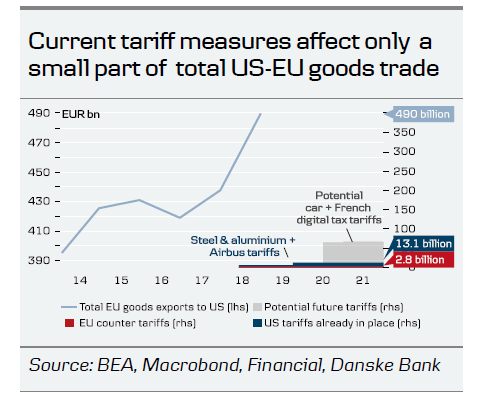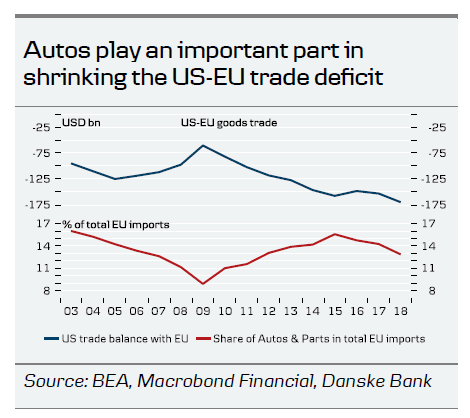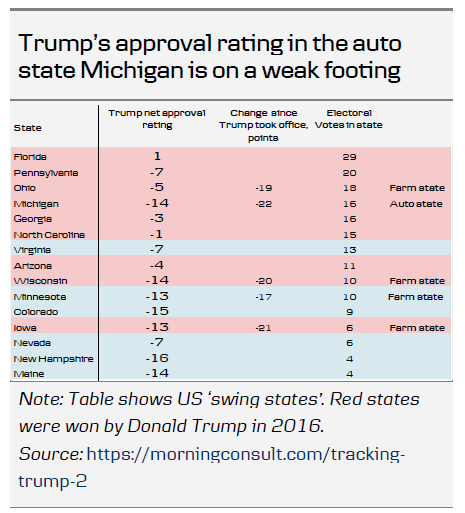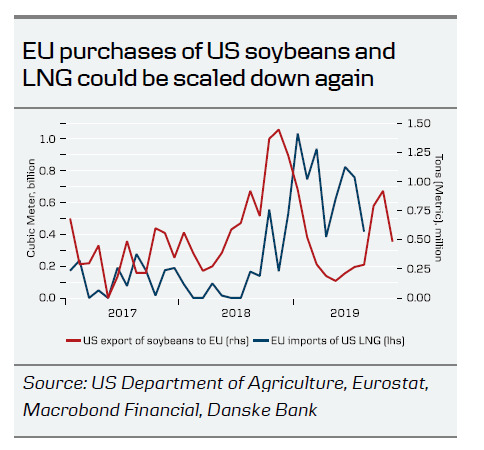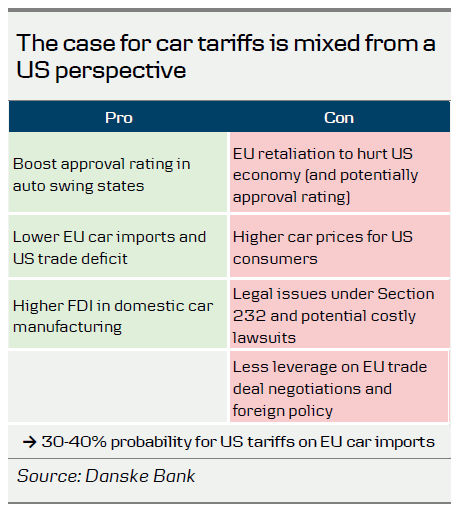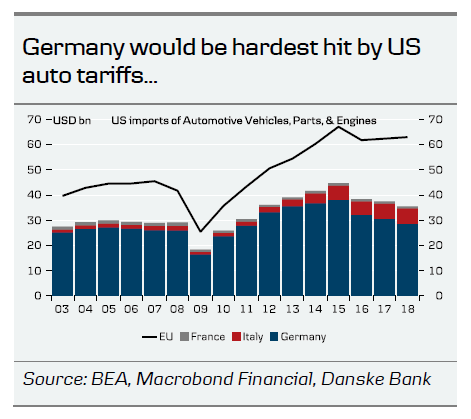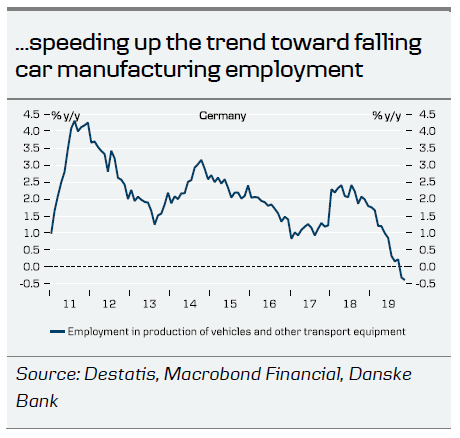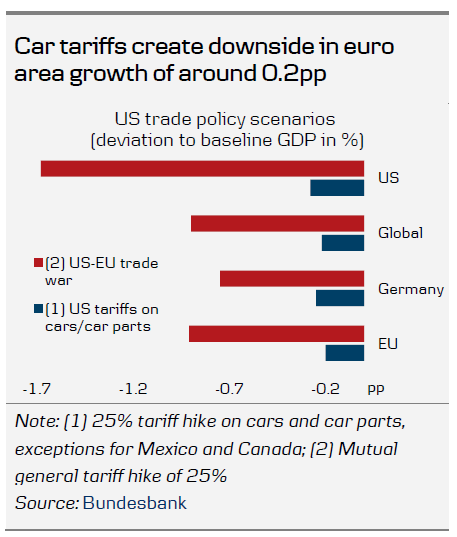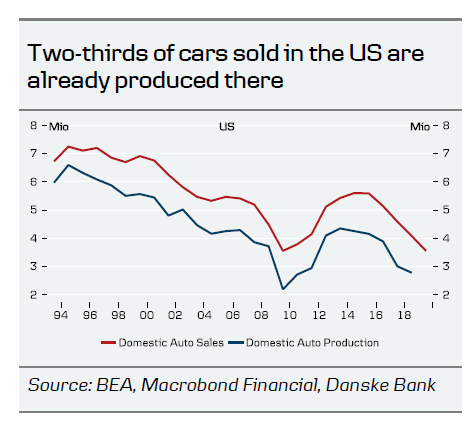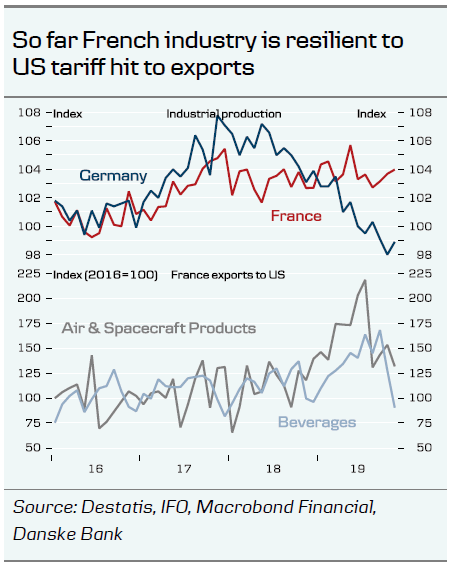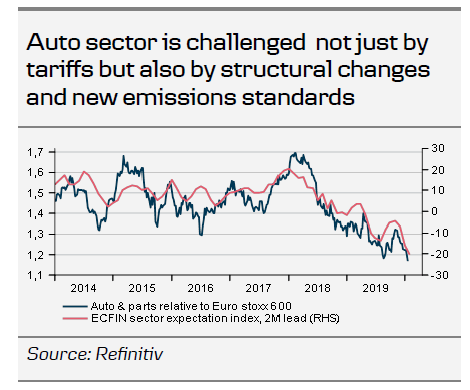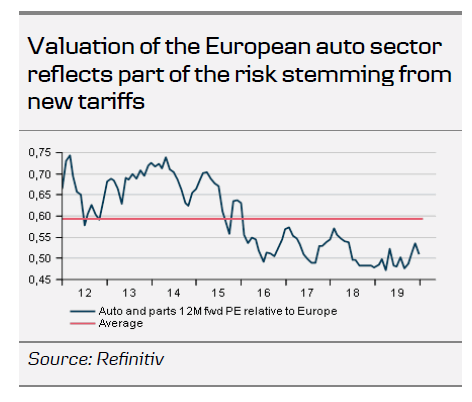- We expect the US administration’s trade policy to shift focus to Europe in 2020, but do not expect a wider EU-US trade war.
- We see 30-40% probability of US tariffs on European car imports hitting in H1 20, in light of both political and legal complexities. In the event of car tariffs, we see downside risks to euro area and German GDP growth of 0.1-0.2%.
- We still see a tangible risk of further US tariff measures for EU products under the ongoing Airbus-Boeing dispute in the coming months, while progress on an EU-US deal on industrial goods is set to remain sluggish.
- Fixed income markets do not currently embed an EU-US tariff premium, in our view. Should the US impose tariffs, we would expect European yields to take a leg lower towards levels seen in H2 19 and European equities to suffer.
As the US and China have sealed the phase-one trade deal and the USMCA agreement finally passed Congress, fear has built that President Trump’s trade ire will soon shift to another region: Europe. In December, US Trade Representative (USTR) Lighthizer already warned that ‘dealing with Europe is something that’s very important and the president has focused on’. At the World Economic Forum (WEF) in Davos President Trump just repeated his tariff threat if an EU trade deal cannot be reached before the US election. So will 2020 turn out to be the year when the trade war shifts from China to Europe, unravelling the nascent cyclical rebound of recent weeks?
Tensions between the US and EU regarding trade policies are not a new feature and have simmered since 2018. The start was marked by the decision by the US to slap import tariffs on European steel and aluminium in June 2018. As a consequence the EU introduced counter tariffs on a range of US food and consumer products worth EUR2.8bn, with the option of another EUR3.6bn by June 2021 (or earlier in case of a positive finding in the WTO dispute settlement). While the steel and aluminium dispute remains unresolved, three additional areas of contention have since opened up.
US auto tariffs: easier said than done
The most important one from an economic perspective remains the question about car tariffs. A key focus of the Trump administration is to improve the US trade deficit with the EU, which has widened since the financial crisis. At the same time, the share of European cars and car parts in total US imports from the EU has steadily increased. Hence, it is not so surprising that US trade tactics have singled out this important sector.
In February 2019 the US Department of Commerce concluded that imports of automobiles and certain automotive parts pose a threat to national security as they affect US producers’ global competitiveness and R&D needed to maintain US military supremacy. The move relied on the infamous Section 232 of the 1962 Trade Expansion Act, which originally was intended to protect America’s Cold War-era defence industrial base and which the Trump administration has previously used to justify the steel and aluminium tariffs. Although the President concurred with the findings of the report, he refrained from imposing tariffs right away and instead directed USTR Lighthizer in May 2019 to enter into negotiations with the EU, Japan and other major car exporters to address the issue at hand within 180 days
While Japan was able to strike a mini deal with the US on the contentious car issue on the side-lines of the UN meeting in September and Mexico, Canada and South Korea will be shielded from tariffs through the USMCA and KORUS deals, progress on the US-EU trade deal on industrial goods has been slight. Former EU Commission President Juncker originally initiated the talks in July 2018. Since then agreements in part have been reached on issues such as increased EU purchases of LNG and soybeans and regulatory cooperation, however disagreements still abound about the actual scope of the deal (see EU’s Progress Report). While US negotiators are keen to include agricultural products, the EU wants to limit the deal strictly to industrial goods and proposals by Europeans to include automobiles in the agreement have repeatedly been turned down from the US side, in fear that it would further boost EU car exports to the US. We have a hard time seeing this issue being resolved in the near future, even if the stalled talks could be reinvigorated with new momentum after EU Commission President Ursula von der Leyen’s visit to Washington in February.
With an EU-US trade deal still not on the horizon anytime soon, the risk of a unilateral move by the US on European car imports remains tangible. Especially the political temptation to boost his approval rating ahead of the election in the auto states of Michigan and Ohio might feature prominently in President Trump’s deliberations for tariffs (see chart).
On the other hand, the political argument is not straightforward, as the EU’s retaliatory response – which we expect to come relatively swiftly in the event – could well see Trump’s move backfire. In a sign of goodwill and as part of the negotiations on a deal on industrial goods, the EU has already increased imports of US LNG and soybeans significantly since July 2018 (see chart). These purchases would likely be redirected to other countries as part of the retaliation strategy and we also expect other US agricultural and energy products to feature high on the EU’s list of rebalancing measures.
Further, higher car prices for US consumers are also unlikely to win votes. The US imported cars and car parts in the volume of USD63bn from the EU in 2018 and the Michigan-based Center for Automotive Research has estimated that new car prices in the US would rise by USD2750 on average in response to a 25% import tariff.
Furthermore, when Trump again chose to dither and the 180 days’ deadline for action under Section 232 slipped on 14 November 2019, the question of car tariffs took on an additional legal dimension. While some trade law scholars argue the Section 232 provision explicitly requires action within a certain time period, others argue that the expiration of the 180 days does not preclude future action in response to a national security risk (see discussion here). All this does not rule out a move from the US administration nevertheless – it has surprised the market many times before in 2019 – but it increases the risk of costly lawsuits from car manufacturers in the wake of a tariff hike.
In sum, we think the political arguments for the Trump administration to move ahead with the tariffs are mixed. While it could boost Trump’s re-election chances in important swing states, the US would also forfeit an important pressure point to push for European concessions in the trade negotiations or exert leverage on European foreign policy (as recently illustrated with the triggering of the Iran nuclear deal dispute settlement mechanism, see story). Additional legal complexities and a seeming preference to avoid fighting a trade war with Europe on too many fronts (see more below) in sum leave us to see only a 30-40% risk of car tariffs being introduced in H1 20
Car tariffs alone would not suffice to trigger a recession
While we see less than a 50% chance of car tariffs hitting within the next 6M, it is important to stress that the car industry plays a crucial role in many European economies, not only in manufacturing but also in terms of a range of services linked to the sector. Some 13.8m jobs directly and indirectly depend on the industry (representing c. 6% of total EU employment). Among European countries, Germany is by far the largest exporter, accounting for some 8% of total US imports of cars and car parts in 2018 and some 17% of total German manufacturing employment is linked to the car sector. Apart from Germany, Eastern European countries such as Hungary, Czech Republic and Slovakia also have a big domestic auto industry and would feel the repercussions of tariffs, despite their direct exports to the US being fairly limited.
Projections from the IFO Institute on the impact of permanent US car import tariffs of 25% find a reduction in German GDP of around EUR5bn (0.02% of GDP) and EUR7bn (0.07% of GDP) for the euro area as a whole. We see these estimates at the lower end of the spectrum as car tariffs would hit the euro area economy at a sensitive time when a nascent stabilisation in the manufacturing downturn has just taken shape and confidence remains on shaky grounds. Tariffs would not only work their direct effect through the export channel, but indirectly also dampen investment decisions and speed up the trend towards falling manufacturing employment that has already taken shape in Germany. Bundesbank simulations on tariff escalations find slightly larger impacts of around 0.2pp (see chart).
In sum, the overall economic effect is difficult to gauge and will not least depend on the retaliatory response from the EU side. However, in the event of car tariffs, we see downside risks to our annual GDP baseline forecasts for 2020-21 in the magnitude of 0.1-0.2% for Germany and the euro area as a whole. That said, we doubt that a hit from auto tariffs will suffice to plunge the region into recession. For this, a wider USEU trade war would have to ensue, with significant tariff increases on a majority of bilateral trade.
On a more structural level, US car tariffs would likely weaken Europe’s appeal as an auto industry hub and speed up the trend towards moving production closer to the final consumer. In 2019 German manufacturers already stepped up their US-based production by some 4% and a similar trend is visible when it comes to suppliers. Two–thirds of cars sold in the US are already produced there and this share might well increase in the future. IFO findings concur this, projecting German car exports to the US to fall by almost 50% in the long run in the event of permanent tariffs. Hence, while the short-run economic impact is somewhat ambiguous, in the long run the car industry would likely lose some of its economic importance for Europe.
Beware of further US tariff measures in Airbus-Boeing dispute
As Germany’s car industry remains on high alert regarding a potential hit from tariffs, there has been another country that has seen its US trade policy worries grow: France has found itself as one of the major victims not only of the US decision to impose tariffs on European wine, cheese and airplane parts in retaliation to illegal Airbus subsidies, but recently also saw its exports of food, beverages and luxury goods come into the line of fire due to its digital services tax (DST).
Latest developments point to a de-escalation on the DST issue, with President Macron and President Trump striking a ceasefire at the WEF that would suspend a US tariff move at least until next year while negotiations for an OECD-wide deal on DST continue. Other countries, like Spain, Italy and Austria, which are pursuing similar plans on a digital tax might, however, still face tariffs in the future.
Less cheering is the picture with regard to the ongoing dispute regarding illegal Airbus and Boeing subsidies. In October, the US imposed a 10% tariff on large civil aircraft and a 25% tariff on agricultural and other products. However, currently the US is not fully utilising the WTO-authorised amount of rebalancing measures against the EU of USD7.5bn annually, leaving us to see a tangible risk that the US will either extend the list of taxed products or impose even higher tariff rates on existing ones in the coming months. A consensual solution as in case of the French DST remains unlikely in our view, at least before the WTO verdict on a similar case against illegal Boeing subsidies is announced (expected sometime in the spring of 2020).
In sum, we expect the US administration’s trade policy increasingly to shift focus towards the EU, but to not evolve into a full trade war with Chinese dimensions. The recent digital tax ceasefire and placating comments from EU Trade Commissioner Phil Hogan after his meetings in Washington point to a US preference not to open up conflicts on too many fronts. However, we still see a tangible risk of further US tariff measures for EU products in the coming months. While this could cause some setbacks in the positive market sentiment, we expect the economic impact of these to be fairly limited. So far the French industry seems to weather the tariff storm quite well, although exports of affected goods slowed in Q4 19. The WTO sanction amount of USD7.5bn also constitutes only 0.02% of total EU goods trade with the US and in the absence of a wider EU-US trade war ensuing, we do not think they will suffice to unravel the nascent recovery that is taking shape in Europe.
Fixed income markets have not yet priced an EU-US tariff premium
Although the recent Iran-US tensions and Chinese coronavirus epidemic have reminded markets of the uncertainty that may strike, we judge that fixed income markets currently do not embed an EU-US tariff premium. That means, should the EU and US impose tariffs we expect European yields to take a leg lower towards levels seen in H2 19. Specifically, we could see 10Y German Bund yields touching the -50bp level again as well as some credit spread widening to the periphery.
European equities to suffer in case of new US car tariffs
The car sector is much more important in Europe than in the US and has experienced multiple challenges over the last couple of years, with car sales stalling, the switch towards electric cars and new emissions standards, to name a few. New tariffs coming from the US would surely make things worse for the sector and add to the risk of European equities underperforming those in the US.
That said, this is not an entirely new risk and is part of the reason why European equities are cheaper than US ones. With the odds we currently see of the US imposing tariffs on European cars and the expected implications, we could argue that this is already in the prices. While we should be past the worst on new emissions standards when it comes to phase 1 and 2, the shift towards electric cars is an open question, but for now investors are clearly betting that new pure electric cars producers will be the global winners going forward. We are not so sure about that and, given the steep discounts they are trading at, we see significant upside potential for the sector. However, we still think it is too early to overweight the European auto and parts sector now.




